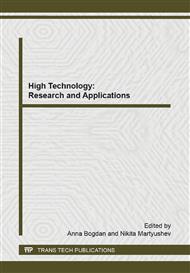[1]
Sinha S.R., Briscoe B.J. Polymer Tribology, Imperial college Press, 2009, London, 689р.
Google Scholar
[2]
Zou Vaobaug, Feng Vongeheng, Wang Lu, Liu Viaobo. Processing and properties of MWNT/HDPE composits, Carbon, 42, 2, (2004) 271-277.
DOI: 10.1016/j.carbon.2003.10.028
Google Scholar
[3]
Myshkin N.K., Petrokovets M.I., Kovalev A.V. Tribology of polymers: Adhesion, friction, wear and mass-transfer, Tribology International, 38 (2005) 910-921.
DOI: 10.1016/j.triboint.2005.07.016
Google Scholar
[4]
Galetz M.C., Blar T., Ruckdaschel H., Sandler K.W., Alstadt V. Carbon nanofibre-reinforced ultrahigh molecular weiht polyethylene for tribological applications, J. of Applied Polymer Science. 104 (2007) 4173-4181.
DOI: 10.1002/app.26058
Google Scholar
[5]
Shipway P.H., Ngao N.K. Microscale abrasive wear of polymeric materials, Wear. 255 (2003) 742-750.
DOI: 10.1016/s0043-1648(03)00106-6
Google Scholar
[6]
Unal H., Sen U., Mimaroroglu A. Abrasive wear behavior of polymeric materials, Materials and Design. 26 (2005) 705-710.
DOI: 10.1016/j.matdes.2004.09.004
Google Scholar
[7]
Lucas A.A., Ambrosio J.D., Otaguro H. Abrasive wear of HDPE/UHMWPE blends, Wear. 270 (2011) 576-583.
DOI: 10.1016/j.wear.2011.01.011
Google Scholar
[8]
Chaozong L., Ren L., Arnell R.D., Tong J. Abrasive wear behavior of particle reinforced ultrahigh molecular weight polyethylene composites, Wear. 225 (1999) 199-204.
DOI: 10.1016/s0043-1648(99)00011-3
Google Scholar
[9]
Panin S.V., Kornienko L.А., Piriyaon S., Ivanova L.R., Shilko S.V., Pleskachevskii Yu.M., Orlov V.М. Antifrictional nanocomposites based on chemically modified ultrahigh molecular weight polyethylene (UHMWPE) Part I. Mechanical and tribotechnical properties of chemically modified UHMWPE, Friction and wear. 32, 3 (2011).
DOI: 10.3103/s1068366611030093
Google Scholar
[10]
Panin S.V., Kornienko L.А., Piriyaon S., Ivanova L.R., Shilko S.V., Pleskachevskii Yu.M., Orlov V.М. Antifrictional nanocomposites based on chemically modified ultrahigh molecular weight polyethylene (UHMWPE) Part II. Influence of nanofillers on mechanical and tribotechnical properties of chemically modified UHMWPE, Friction and wear. 32, 4 (2011).
DOI: 10.3103/s106836661104009x
Google Scholar
[11]
Panin S.V., Kornienko L.А., Wannasri S., Ivanova L.R., Shilko S.V. Comparison of the effectiveness of modification UHMWPE by nanofibers (C, Al2O3) and nanoparticles (Cu, SiO2) for obtaining antifrictional composites, Friction and wear. 31, 6 (2010).
DOI: 10.3103/s1068366610060097
Google Scholar


